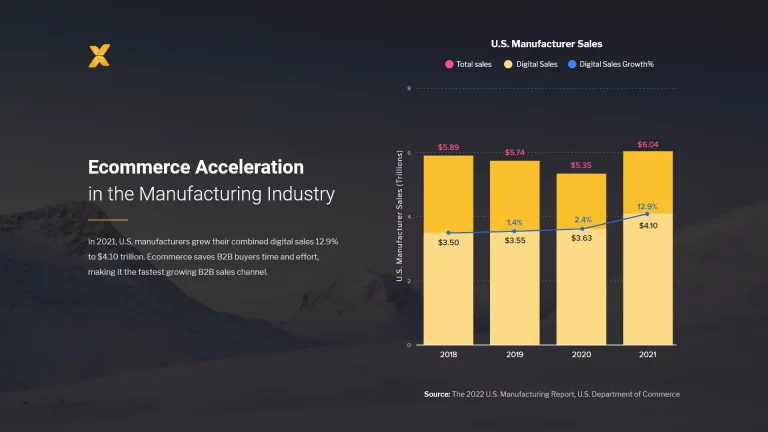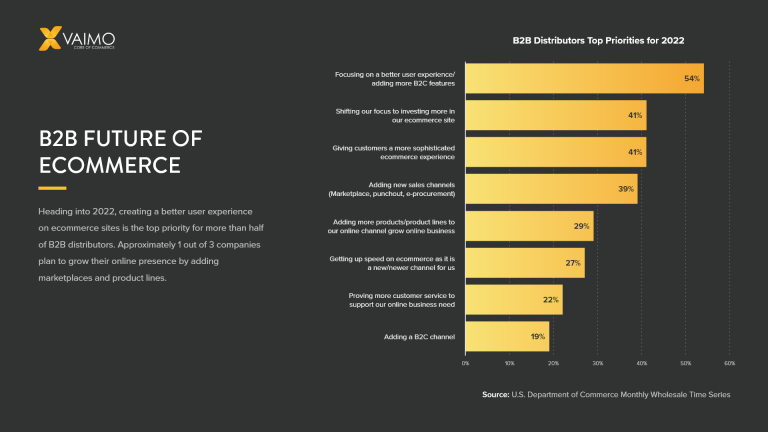Today’s B2B ecommerce industry has an incredibly broad reach. It is large and complex, encompassing everything from marketing, commerce infrastructure, and payments technology to procurement and supply-chain solutions with plenty of other areas in between. Of all of these, there is one area in the B2B ecommerce sector that holds great promise: marketplaces.
Several companies are already cashing in on this retail model, with a handful of marketplaces responsible for shaping the future of professional eCommerce going forward. Two of the major and most well-known players, Alibaba and Amazon, have generated $11 billion and $4 billion respectively on their platforms, despite their very different business models. But what’s driving this growth, and how can your business become a part of it?
The Growth of B2B eCommerce Marketplaces
Traditionally, the B2B sector has been built on long-term trust between buyers and sellers, as products are complex and typically require substantial advice and guidance throughout the purchase journey. In addition, the buying process can be somewhat negotiable, and it is not uncommon for sellers to set their own prices and payment terms for their customers. As a result, the B2B market has been slow to transform. And, despite its size, it lags behind the B2C eCommerce market.
Recently, we are starting to see the B2B market catch up. And this momentum is largely driven by changing B2B purchasing behavior:
- 74% of B2B buyers research at least half of their work purchases online
- 61% of B2B buyers research products on mobile devices
- 56% of B2B buyers expect to make half or more of their work purchases online in the next three years
- 91% of B2B buyers prefer to buy online once they have decided what to buy
Because B2B buyers are also B2C customers, they naturally want the same kind of purchasing experience in their professional environment as they encounter in the consumer world. This results in the B2B buyer becoming much more tech-savvy, pressuring digital and multichannel modes to offer new solutions for the B2B sector.
How COVID-19 Changed B2B Marketplaces
B2B Marketplaces are currently seeing a significant growth in popularity. This is largely fueled by recent infrastructure improvements, better payments and security on the back-end, and an increased need for companies to conduct business online during the pandemic. Before the pandemic, B2B marketplaces were already growing quicker than most of the B2C marketplaces that came before them. They were expected to generate $3.6 trillion in sales by 2024—up from an estimated $680 billion in 2018, according to payments research firm iBe TSD.
Then, when COVID shutdowns hit, even more companies scrambled to shift all purchasing online. According to a recent survey conducted by Digital Commerce 360, 20% of purchasing managers spent ‘more’ and 22% spent ‘significantly more’ on marketplaces during the pandemic. It makes sense as buyers of diverse business products scrambled and searched for new ways to purchase goods and services given the disrupted supply chains during the COVID-19 pandemic. For this reason, they flocked to ecommerce marketplaces. In fact, 89% of purchasing managers surveyed stated that they are turning to (or continuing to use) B2B marketplaces as a result of COVID-19 disruptions.
The marketplace model allowed B2B companies to quickly add new in-demand products such as personal protective equipment (PPE) to their assortment. And they were able to do this without going through the process of sourcing the inventory, purchasing and stocking the product, and managing the product information and details. Instead, all of this was handled by the seller, and these additions blended seamlessly with the other products listed on the website.
Benefits of Vertical Industry Marketplaces
Several B2B companies are having success with vertical industry marketplaces. These marketplaces often provide a large part, or all, of the assortment needed for an outcome (as a result enabling one-stop shopping) as well as processes that are tailored for the industry.
In addition, these marketplaces can reduce and sometimes even eliminate channel conflict if distributors are required to participate in making the model successful. Distributors often benefit from the opportunity to compete on value propositions instead of price, and to deliver unique value with access to inventory, access to complementary products, and in some marketplaces access to installation services.
B2B manufacturers can also benefit from a marketplace model in the following ways:
- Controlling the brand experience by controlling the core catalog
- Enforcing quality standards for extended catalogs from distributors and dealers
- Providing tailored buying journeys serving complex needs of B2B including merchandised rebuying with fewer out-of-stocks, and site search across many inventory sources
- Accessing more buyers in adjacent industries and new geographies
- Leveraging distributors and/or dealers with inventory
As such, it is not surprising that top B2B organizations like Toyota Material Handling, Satair, and HPE have decided to launch their own online marketplaces. They are increasing assortment faster, building more direct connections with buyers, and gaining valuable data and insights along the way—all while preserving their relationship with channel partners.
For the B2B buyer, the one-stop shopping value proposition of a vertical B2B marketplace offers the following benefits:
- The simplicity and transparency of using a single site provided by a trusted manufacturer rather than multiple sites from the manufacturer and distributors.
- Access to the manufacturer’s catalog and full or partial catalogs from distributors paired with localized pricing, inventory, and delivery options.
- The purchase process can appear to be a single transaction that effectively masks the complex order management processes of many participating distributors.
Types of Marketplace Business Models
Initially, marketplaces were created to broaden the product offering and give customers as much choice as possible. Today you can find a wide variety of different B2B marketplaces, but the four most common business models are:
1. One-Stop-Shop
The “one-stop-shop” is the most commonly seen business model in B2B marketplaces and it represents a natural transition from the traditional online stores of the past to the more relevant marketplace model that today’s shoppers prefer. Many B2B marketplaces started as traditional online stores and evolved into one-stop shops via horizontal growth and the addition of long-tail products to the business’s current category.
2. Extending the Distribution Channel
A B2B marketplace can also be a way for companies to add a new distribution option for suppliers. Or, a producer with a fragmented distributor network and a strong brand can integrate its distributors onto a platform for them to sell their products. In this scenario, the company that creates the marketplace adds this new channel as a service to its distributors and, in return, benefits from closer access to end customers and a better overview of product inventories.
3. Procurement Network
The procurement network is the opposite of broadening the product offering and offering customers as much choice as possible. Instead, it concentrates the offering so that the marketplace initiator can negotiate prices on items sold on its platform. This model is often used by large corporations with many different subsidiaries and procurement departments, complicating the process of supplying all the subsidiaries with needed products. Creating a procurement marketplace allows corporations to simplify and standardize the product offering for its subsidiaries, gain control over the procurement portfolio, and realize substantial cost benefits. The procurement network model is often a closed business only for members such as subsidiaries or members of a purchasing group.
4. Business Model Transformation
Business model transformation marketplaces originated in the B2C service industry by matching demand and supply in unstructured markets. Examples include Vrbo, Airbnb, Lyft, and Uber. This marketplace model has recently entered the B2B market for services such as asset sharing and freelance placements, and even products. In this model, both parties benefit from transparency where the elimination of middlemen and transactions become more fluid. In addition, business model transformation allows for two different kinds of revenue: transaction fees or subscription models.
Addressing the Challenges of B2B eCommerce Marketplaces
The first step in entering the marketplace space is to define a suitable marketplace strategy. And since the strategy and model you decide on is the foundation for your success, it is critical that you think through and consider the following key challenges and success factors before you get into developing your business model:
Change Management
For most companies, creating a marketplace means building a new business function and sales channel that needs the right leadership, funding and resources. A common mistake is to place this new business function in an existing department such as sales, marketing or IT and assign ownership to an existing leader who doesn’t have the required knowledge or skill set to build and manage a marketplace. Sure, this new business function will need support and engagement from marketing, sales and IT and other business units to be successful, so it makes sense to not completely separate this new sales channel from the rest of the organization. However, creating a marketplace requires organizations to rethink their view of the business with plenty of leadership, support and conviction to move forward with this business model. As such, bring on resources who know how to build a marketplace, elevate the leader of this new function to be part of the C-suite or at least report directly into the C-suite. And make sure that senior management and the entire company is convinced of the value and usefulness of this new strategy, as all departments will be affected by the changeover.
New Skill Sets & Competencies
Launching and managing a marketplace requires a new set of skills and competencies that most traditional B2B organizations don’t already have. Organizations that try to rely on existing teams to build and launch a marketplace are oftentimes doomed to fail or end up spending more money than needed or planned. For example, marketplace managers must hire sellers, which is a job that demands a totally different skill set compared to the ones required to select and negotiate products in the wholesale business. In addition, marketplaces also require new competencies for data analytics proficiency and online marketing.
Technology
There are many options when it comes to the approach and technology you use for your marketplace. First, should you build something from scratch or should you buy something off the shelf? There are several robust and mature PaaS (Platform as a Service) and SaaS (Software as a Service) options available on the market today. Unless your industry and products have some very unique needs, the off-the-shelf option is a great first step. When choosing your marketplace technology, make sure it integrates seamlessly into your existing business systems.
In addition, the platform design should integrate purchasing experiences from the B2C world. Key functionality to consider is an intelligent search function with robust filters and selection criteria, the ability to display the products with clear, consistent, detailed names and descriptions, and a clear and intuitive purchase process with the right payment options and experience. Payments are a central and crucial component and if done poorly can lead to cart abandonment and reduced sales. It involves both offering the right payment options to meet your buyers preferences and a streamlined customer experience. Fortunately, there are several third party options to choose from who will make sure you also comply with national and international legal and financial requirements (and even special accreditation of financial institutions).
And if you are planning to let your suppliers sell their products on your marketplace, make sure the supplier onboarding process is simple and intuitive so that you have a minimal investment in managing that process.
How to Build a Successful B2B eCommerce Marketplace
Now that you have considered and addressed the key challenges with creating a marketplace it is time to start the process of making it happen. To increase your chance of launching a successful B2B ecommerce marketplace, follow these guidelines:
Define a clear marketplace strategy
Start by identifying the right market segment to operate in by analyzing it holistically. Look at the size, dynamics, competitors, barriers for entry, customer requirements, and so on. The information you gather should guide you into the right marketplace model for your business.
Develop a client-centric solution
Ultimately, your buyers are at the heart of your business, and marketplaces are no exception. Therefore, before you define your marketplace customer experience and technological requirements, spend time exploring and understanding the expectations of both current and future customers of the marketplace.
Commit to a 2-3 year budget
A common mistake is to underestimate the time it takes to breakeven and to start making a profit. Remember that you are building a new capability and the return on investment will not be immediate (it often takes 2-3 years). Commit to a budget that is realistic and will get you past breakeven. Senior management must be patient, have conviction in the business model and be willing to support the marketplace over the medium-term.
Test & learn quickly
Don’t try to build the perfect marketplace in your first launch. Instead, use an agile development approach with regular testing of milestones and continued improvement of technology in subsequent phases. As you gather insights from your initial build, you can evolve and update in a scaled manner.
Make supply a priority
Supply can make or break a marketplace and it is one of the two pillars of the business model. Today, some sellers may lack the digital maturity to be part of a marketplace model. Tailor the supplier experience and platform onboarding initiatives relative to their particular needs.
Pick the right partner
Work with a partner that has the right strategic, UX/design & technology expertise and solution development experience to guide you through the process and help you achieve your vision and goals. At Vaimo, we understand all of the factors involved in creating a successful, scaleable B2B eCommerce marketplace. Reach out today for a consultation to learn how you can leverage this exciting eCommerce business model to reach new markets and drive your B2B business.







